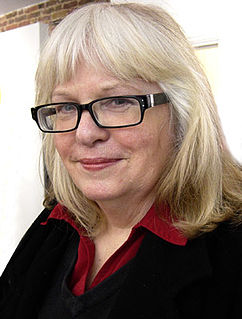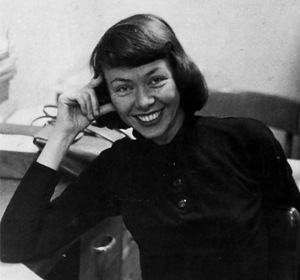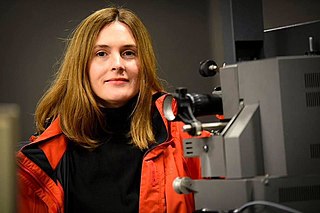Related Research Articles
Guerrilla Girls is an anonymous group of feminist, female artists devoted to fighting sexism and racism within the art world. The group formed in New York City in 1985 with the mission of bringing gender and racial inequality into focus within the greater arts community. The group employs culture jamming in the form of posters, books, billboards, and public appearances to expose discrimination and corruption. They also often use humor in their work to make their serious messages engaging. They are known for their "guerilla" tactics, hence their name, such as hanging up posters or staging surprise exhibitions. To remain anonymous, members don gorilla masks and use pseudonyms that refer to deceased female artists such as Frida Kahlo, Kathe Kollwitz, and Alice Neel. According to GG1, identities are concealed because issues matter more than individual identities, "Mainly, we wanted the focus to be on the issues, not on our personalities or our own work."

Alice Neel was an American visual artist, who was known for her portraits depicting friends, family, lovers, poets, artists, and strangers. Her paintings have an expressionistic use of line and color, psychological acumen, and emotional intensity. Her work depicts women through a female gaze, illustrating them as being consciously aware of the objectification by men and the demoralizing effects of the male gaze. Her work contradicts and challenges the traditional and objectified nude depictions of women by her male predecessors. She pursued a career as a figurative painter during a period when abstraction was favored, and she did not begin to gain critical praise for her work until the 1960s. Neel was called "one of the greatest portrait artists of the 20th century" by Barry Walker, curator of modern and contemporary art at the Museum of Fine Arts, Houston, which organized a retrospective of her work in 2010.

Eva Hesse was a German-born American sculptor known for her pioneering work in materials such as latex, fiberglass, and plastics. She is one of the artists who ushered in the postminimal art movement in the 1960s.

Alexis Jan Atthill Hunter was a New Zealand painter and photographer, who used feminist theory in her work. She lived and worked in London UK, and Beaurainville France. Hunter was also a member of the Stuckism collective. Her archive and artistic legacy is now administered by the Alexis Hunter Trust.

Hannah Wilke was an American painter, sculptor, photographer, video artist and performance artist. Wilke's work is known for exploring issues of feminism, sexuality and femininity.
Lucy Rowland Lippard is an American writer, art critic, activist, and curator. Lippard was among the first writers to argue for the "dematerialization" at work in conceptual art and was an early champion of feminist art. She is the author of 21 books on contemporary art and has received numerous awards and accolades from literary critics and art associations.

The feminist art movement in the United States began in the early 1970s and sought to promote the study, creation, understanding and promotion of women's art. First-generation feminist artists include Judy Chicago, Miriam Schapiro, Suzanne Lacy, Judith Bernstein, Sheila de Bretteville, Mary Beth Edelson, Carolee Schneeman, Rachel Rosenthal, and many other women. They were part of the Feminist art movement in the United States in the early 1970s to develop feminist writing and art. The movement spread quickly through museum protests in both New York and Los Angeles, via an early network called W.E.B. that disseminated news of feminist art activities from 1971 to 1973 in a nationally circulated newsletter, and at conferences such as the West Coast Women's Artists Conference held at California Institute of the Arts and the Conference of Women in the Visual Arts, at the Corcoran School of Art in Washington, D.C..

Susan Hiller was an American-born artist who lived in London, United Kingdom. Her art practice included installation, video, photography, performance and writing.
Mierle Laderman Ukeles is a New York City-based artist known for her feminist and service-oriented artworks, which relate the idea of process in conceptual art to domestic and civic "maintenance". She has been the Artist-in-Residence at the New York City Department of Sanitation. Her art brings to life the very essence of any urban center: waste flows, recycling, sustainability, environment, people, and ecology.
Joan Snyder is an American painter from New York. She is a MacArthur Fellow, a Guggenheim Fellow, and a National Endowment for the Arts Fellow (1974).
Mary Kelly is an American conceptual artist, feminist, educator, and writer.

May Stevens was an American feminist artist, political activist, educator, and writer.
PayneShurvell is a contemporary art gallery based in William Road in Kings Cross, London. It shows the work of Andrew Curtis, Aidan McNeill, Wrik Mead, Margaret Harrison, Anka Dabrowska and other internationally-recognised artists.
The feminist art movement refers to the efforts and accomplishments of feminists internationally to produce art that reflects women's lives and experiences, as well as to change the foundation for the production and perception of contemporary art. It also sought to bring more visibility to women within art history and art practice. By the way it is expressed to visualize the inner thoughts and objectives of the feminist movement to show to everyone and give meaning in the art. It helps construct the role to those who continue to undermine the mainstream narrative of the art world. Corresponding with general developments within feminism, and often including such self-organizing tactics as the consciousness-raising group, the movement began in the 1960s and flourished throughout the 1970s as an outgrowth of the so-called second wave of feminism. It has been called "the most influential international movement of any during the postwar period."
Mary Beth Edelson was an American artist and pioneer of the feminist art movement, deemed one of the notable "first-generation feminist artists." Edelson was a printmaker, book artist, collage artist, painter, photographer, performance artist, and author. Her works have been shown at the Museum of Modern Art, the Smithsonian American Art Museum, and the Museum of Contemporary Art in Chicago.

Juanita McNeely is an American feminist artist known for her bold works that illustrate the nude female experience in her figurative paintings, prints, paper cut-outs and ceramic pieces. Feminist elements in her work include the portrayal of female experiences such as abortion, rape, and menstruation with a display of powerful emotion. Her recurring health problems and expressive figurative compositions have prompted comparisons to Frida Kahlo. According to McNeely, "we as women must continue the struggle to hold on to our rights, or let the children lead the way."
West-East Bag (WEB) was an international women artists network active from 1971 to 1973.

Laida Lertxundi is an artist, filmmaker and professor of fine arts based in the United States and The Basque Country, Spain.

Bailey Doogan is an American artist best known for her large-scale, feminist paintings and drawings that offer an unflinching look at the aging body, especially the female body, and that tackle cultural issues like the equation of beauty with youth. Doogan's artwork has been reviewed in numerous publications, including Art in America, The Nation, Art Journal, Ms., ARTnews and the New Art Examiner. Her work also has been reproduced in Harper's Magazine.
Krysia Nowak, also known as Krysia Danuta Michna-Nowak, is a British painter and designer of Polish descent, working in mixed media.
References
- ↑ Munson, Kim (2015). On Reflection: the art of Margaret Harrison. California, USA: Neurotic Raven. p. 46. ISBN 978-0-9963145-1-0.
- ↑ Great Women Artists. Phaidon Press. 2019. p. 172. ISBN 978-0-7148-7877-5.
- 1 2 Brian, Steven (May–June 2004). "Violence isn't Always Ugly at First". NY Arts Magazine. Retrieved 15 July 2009.
- ↑ Lutyens, Dominic (7 April 2011). "Margaret Harrison: a brush with the law". The Guardian. Retrieved 18 December 2019.
- ↑ "Women and Work". Tate. Retrieved 1 February 2014.
- ↑ "BP Spotlight: Women & Work". Tate Britain. Retrieved 1 February 2014.
- ↑ Deepwell, Katy. "A Chronological List of International Exhibitions on women artists and feminist art practices" (PDF). kt press. Retrieved 1 February 2014.
- ↑ Crickmay, Chris. ""Art and Social Context", its Background, Inception and Development". Journal of Visual Arts Practice. Retrieved 1 February 2014.
- ↑ "Beautiful Ugly Violence: The Brutality of the Everyday". SF Station. 18 August 2004. Retrieved 16 July 2009.
- ↑ Macklin, Karen (3 March 2004). "Art of Fact: Beautiful Ugly Violence's open wounds". SF Weekly. Retrieved 15 July 2009.
- ↑ "Margaret Harrison and The Girls / I am a Fantasy". PayneShurvell. Archived from the original on 17 April 2011. Retrieved 18 December 2019.
- ↑ Lutyens, Dominic (7 April 2011). "Margaret Harrison: A Brush with the Law". The Guardian. Retrieved 7 March 2015.
- ↑ "2013 Prize". Northern Art Prize. Retrieved 1 February 2014.
- ↑ "On Reflection". Ronald Feldman Gallery. Retrieved 7 March 2015.
- ↑ "Azkuna Zentroa – Margaret Harrison. Dialogues between sex, class and violence". Azkuna Zentroa. Retrieved 24 June 2018.